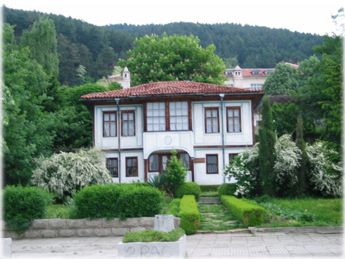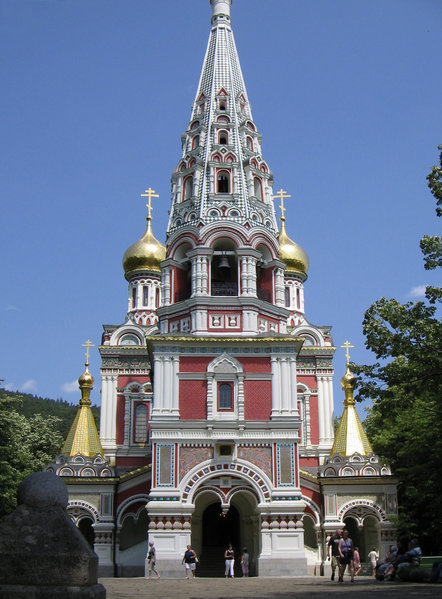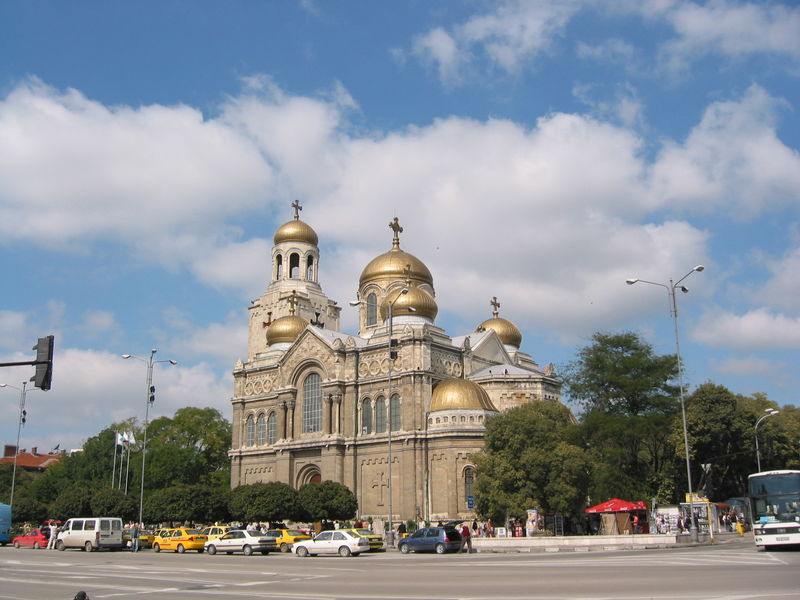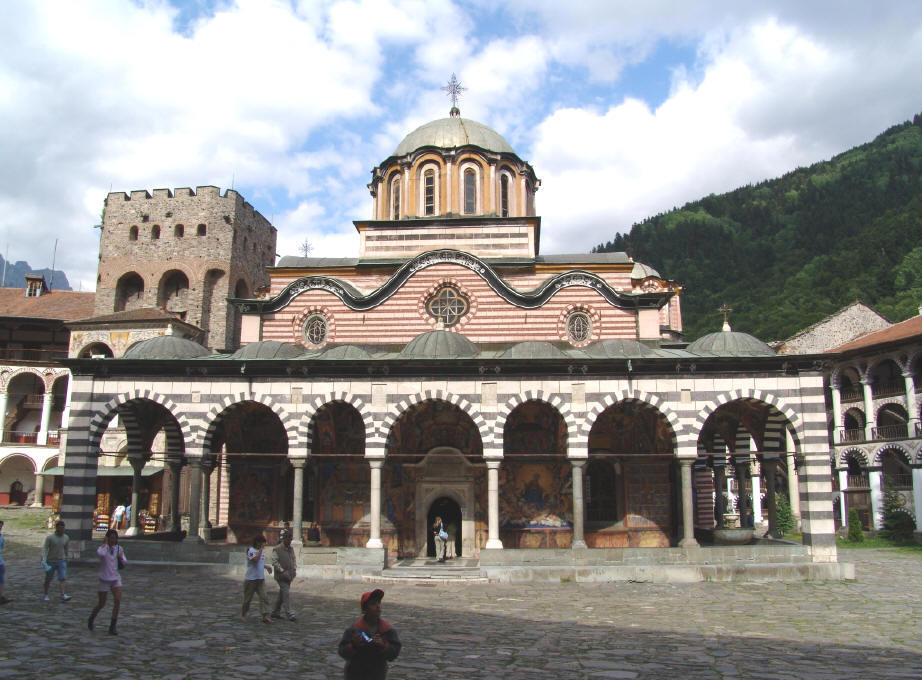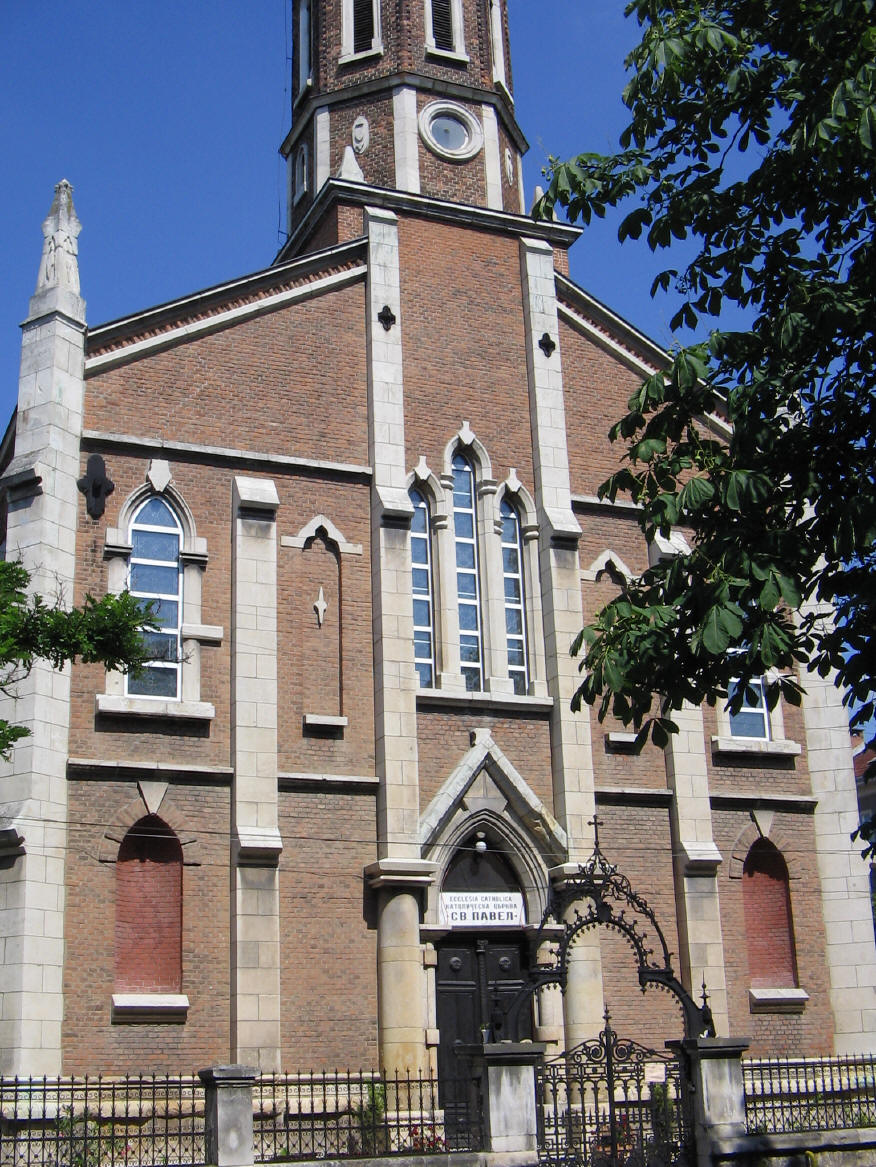|
|
Shipka Memorial Church -
map
The Memorial Temple of the Birth of Christ (Bulgarian:
Храм-паметник „Рождество
Христово“, Hram-pametnik „Rozhdestvo Hristovo“),
better known as the Shipka Memorial Church or
Shipka Monastery is a
Bulgarian Orthodox church built near the town of
Shipka in
Stara Planina between 1885 and 1902 to
Antoniy Tomishko's design in the seventeenth-century
Muscovite style, under the direction of architect
Alexander Pomerantsev. It is, together with the other
parts of the
Shipka Monument complex, dedicated to the
Russian,
Ukrainian and
Bulgarian soldiers that died for the liberation of
Bulgaria in the
Russo-Turkish War, 1877-78.
The temple was officially opened on
28 September
1902 in the presence of
Russian Army generals and many honourable guests. The
opening and consecration of the Shipka Memorial Church
concurred with the 25-year anniversary of the
Battles of Shipka Pass. In 1970, the temple was
proclaimed a national monument of culture.
The church's bell tower reaches a height of 53 m and its
bells, the heaviest of which weighs 12 tons, were cast from
the cartridges that were collected after the battles. In the
temple itself, the names of the Russian regiments and
Bulgarian volunteers are inscribed on 34 marble plates. The
remains of the perished are laid in 17 stone
sarcophagi in the church's crypt ....
Full
article you can find here...
|
|
|
Alexander Nevsky
Cathedral, Sofia
The
St. Alexander Nevsky Cathedral (Bulgarian:
Храм-паметник „Свети
Александър Невски“, Hram-pametnik „Sveti Aleksandar Nevski“) is a
Bulgarian Orthodox cathedral in
Sofia, the capital of
Bulgaria. Built in
Neo-Byzantine style, it serves as the cathedral
church of the
Patriarch of Bulgaria and is one of the largest
Eastern Orthodox cathedrals in the world, as well as one of Sofia's symbols and
primary tourist attractions.
The Alexander Nevsky Cathedral is a cross-domed
basilica featuring an emphasized central dome. The
cathedral's gold-plated dome is 45
m high, with the bell tower reaching 50.52 m. The
temple has 12 bells with total weight of 23
tons, the heaviest weighing 12 tons and the lightest
10
kg. The interior is decorated with
Italian marble in various colours,
Brazilian
onyx,
alabaster, and other luxuirous materials. The
central dome has the
Lord's Prayer inscribed around it with thin gold
letters.
The construction of the St. Alexander Nevsky Cathedral started in 1882 (having
been planned since 1880), when the
foundation stone was laid, but it was in fact built
between 1904 and 1912 in honour to the
Russian soldiers who died during the
Russo-Turkish War of 1877-1878, as a result of which
Bulgaria was liberated from
Ottoman rule. The cathedral was designed by
Alexander Pomerantsev, aided by Alexander Smirnov
and Alexander Yakovlev, as the initial 1884-1885 project of Ivan Bogomolov was
radically changed by Pomerantsev.
Full article and more pictures you can find here...
|
|
|
Dormition of the Theotokos Cathedral, Varna
|
|
|
|
|
|
St. Paul of the Cross Cathedral, Russe
Rousse
(also transliterated as Ruse or Russe;
Bulgarian: Русе
['ru.sɛ]; formerly also Rustchuk) is
the fifth largest city in
Bulgaria, with a population of 178,000. Rousse
is situated in the northern part of the country, on
the southern bank of the
Danube, opposite the
Romanian city of
Giurgiu, 320
km from the capital
Sofia and 200 km from the
Bulgarian Black Sea Coast. It is the most
significant Bulgarian river port, serving an
important part of the international trade of the
country ..
Full article on Wikipedia here..
|
|
|
|
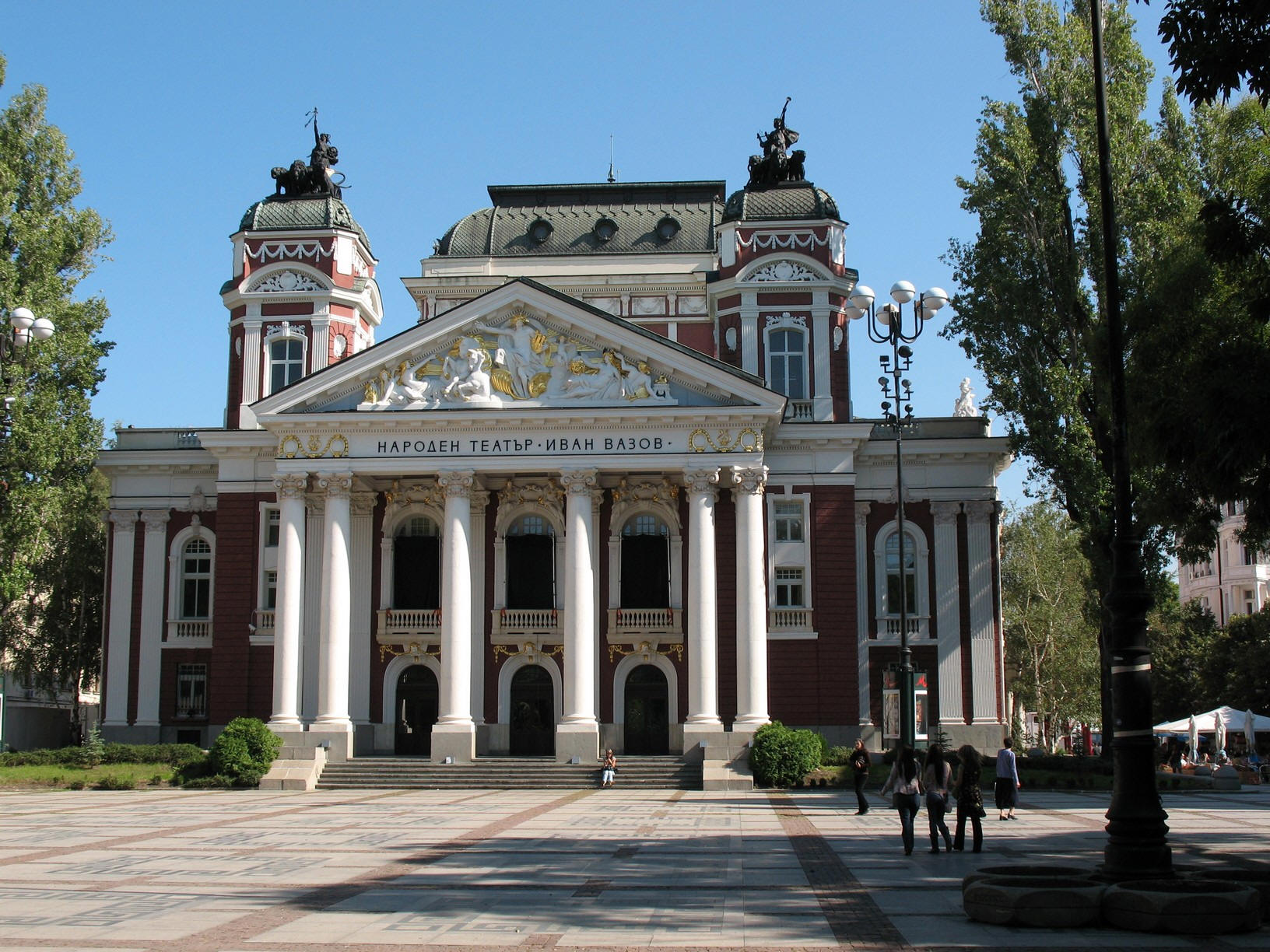 |
National Theatre "Ivan Vazov"
The
Ivan Vazov National Theatre (Bulgarian:
Народен театър „Иван
Вазов“, Naroden teatar „Ivan Vazov“) is
Bulgaria's national theatre, as well as the oldest
and most authoritative theatre in the country and one of
the important landmarks of
Sofia, the capital of Bulgaria. It is located in the
centre of the city, with the facade facing the
City Garden. Founded in 1904 by the artists from the
Salza i Smyah company, it was initially called
simply the National Theatre, but before being named
after the prominent writer Ivan Vazov it also bore the
name of
Krastyu Sarafov between 1952 and 1962. The theatre's
Neoclassical building, designed by famous
Viennese theatre architects
Hermann Helmer and
Ferdinand Fellner,[1]
was finished in 1906 and opened on
3 January
1907. The building was extensively damaged by a fire
in 1923 during an anniversary celebration, but was
reconstructed in 1929 by
German architect
Martin Dülfer.
A theatrical school was
established as part of the National
Theatre in 1925. The
bombing of Sofia in World War II
caused considerable damage to the
building, but it was reconstructed in
1945. Another reconstruction followed in
1971-1975, and a
€100,000 restoration project was
implemented in 2006.[2]
The Ivan Vazov National Theatre
has a well-equipped main stage with 750
seats, a smaller 120-seat stage and an
additional 70-seat one on the fourth
floor ...
Source:
Wikipedia
|
|
|
Rodopi Mountain
You can find here beautiful pine forests, fresh air, mountain lakes
and streams and many opportunities for hiking adventures, wildlife
watching, angle opportunities ( for trout lovers ).
The
Rhodopes (Bulgarian:
Родопи, Rodopi, usually used with a definite
article: Родопите, Rodopite, sometimes also
called Родопа, Rodopa or Родопа планина,
Rodopa planina;
Greek: Ροδόπη, Rodopi, "red aspect") are a
mountain range in
Southeastern Europe, with over 83% of its area in
southern
Bulgaria and the remainder in
Greece. Its highest peak,
Golyam Perelik (2,191 m), is the seventh highest
Bulgarian mountain. The region is particularly notable
for the
Karst areas with their deep river gorges, large
caves and specific sculptured forms, such as the
Trigrad Gorge ...
More info
here ...
Source:
Wikipedia, the free encyclopedia
|
|
|
Town of Bansko
- Map
Bansko, once mainly a stockbreeding
and traveling merchant community, has nowadays become a center of winter
and summer tourism. The mountain peaks near the town, the numerous lakes
and the old pine woods make it a popular site for recreation. In recent
years, the town has gained international popularity after the start of
the annual Bansko Jazz Festival and consequently the annual Bansko
pop-star concert featuring top pop stars. The nearby village of
Banya, located only 5 km from the town, is known for its 27
thermal mineral springs. A new
gondola lift was built in 2003 to replace a minibus ride up to the ski
slopes of Todorka. Several other gondolas and ski lifts are in the
process of being built. These developments, along with the construction
of extensive housing and recreational facilities around the gondola
(which is on the southwest end of the town by the river), have made
Bansko a popular and growing destination ...
Full
info you can find here...
|
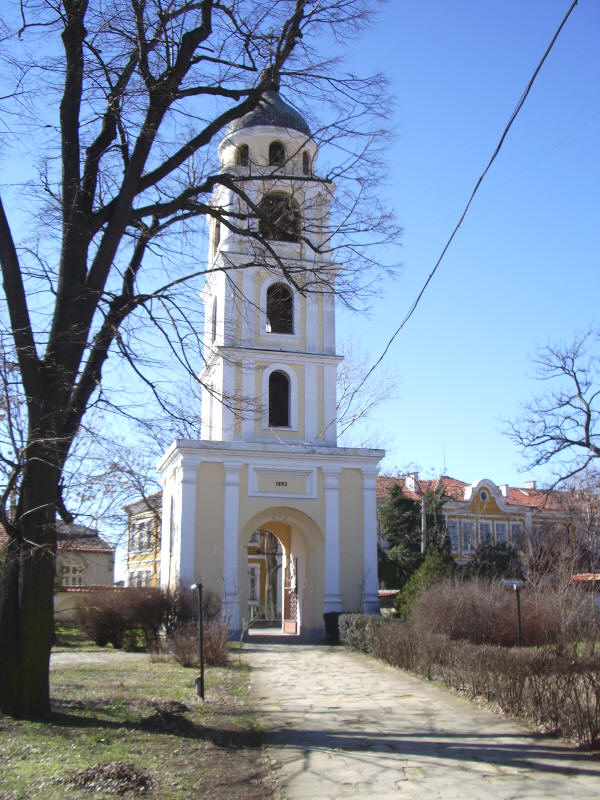
Church St. George, Yambol (rebuilt in 1737)
Pictures taken on 3-rd , March, 2007,
Bulgarian
National Holiday
Liberation Day in
Bulgaria
(1878),
Treaty of San Stefano
(статията на български тук) |
  Yambol (Bulgarian:
Ямбол) is a
city in southeastern
Bulgaria, the administrative centre of
Yambol Province. It lies on both banks of
the
Tundzha in the historical region of
Thrace. Today, the town has 85,966
inhabitants
as of 2006. Yambol (Bulgarian:
Ямбол) is a
city in southeastern
Bulgaria, the administrative centre of
Yambol Province. It lies on both banks of
the
Tundzha in the historical region of
Thrace. Today, the town has 85,966
inhabitants
as of 2006.
Although the surrounding area
has been inhabited since the
Neolithic and was the location of the
Thracian royal city of Cabyle (later
conquered by
Philip II of Macedon and the
Romans, but destroyed by the
Avars in 583), what is today Yambol was
founded by
Roman Emperor
Diocletian in 293 as
Diospolis ('city of
Zeus'). The name later evolved through
Diampolis and Diamboli to become
Yambol.
As the
Slavs and
Bulgars arrived in the
Balkans in the
Middle Ages, the fortress was contested by
the
Bulgarian Empire and the
Byzantines until 1373, when it fell to the
Ottomans after a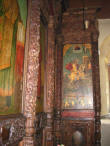 prolonged siege. Yambol
(Ottoman
Turkish Yanbolu) was an important
centre of the Ottoman Empire until liberated by
Russian forces in January 1878 to become part of
Eastern Rumelia and later Bulgaria after the
Unification in 1886. The predominant
religion is
Eastern Orthodoxy with a number of churches
being present (among them one of the
Holy
Trinity, one of
St George and one of
St Nicholas), but there also exist
Eastern Rite Catholic and
Protestant religious buildings, as well as a
15th-century mosque.
Yambol
Peak on
Livingston Island in the
South Shetland Islands,
Antarctica is named for Yambol ... prolonged siege. Yambol
(Ottoman
Turkish Yanbolu) was an important
centre of the Ottoman Empire until liberated by
Russian forces in January 1878 to become part of
Eastern Rumelia and later Bulgaria after the
Unification in 1886. The predominant
religion is
Eastern Orthodoxy with a number of churches
being present (among them one of the
Holy
Trinity, one of
St George and one of
St Nicholas), but there also exist
Eastern Rite Catholic and
Protestant religious buildings, as well as a
15th-century mosque.
Yambol
Peak on
Livingston Island in the
South Shetland Islands,
Antarctica is named for Yambol ...
Source:
http://en.wikipedia.org/wiki/Yambol
|
|








|
|
|
Town of Koprivshtitsa
-
See also: "Old Towns in Bulgaria"
Sunshine colours and romance are what characterize the typical 19th
century atmosphere preserved and lingering in Koprivshtitsa. Every
single house here is part of Bulgaria's history. It was here that the
first shot of the April Uprising against Ottoman rule rang out in 1876.
Although drenched in blood, the uprising resounded in all of Europe ...
Full article you
can find here...
|
|
©2008
Bulgaria
Emil Manchev |
|
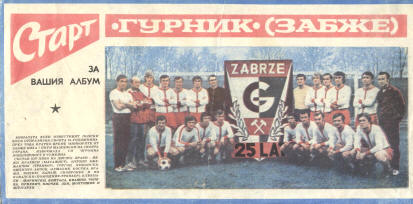

Футболни отбори от вестник "Старт", издания от 1971 до 1982 год. |


